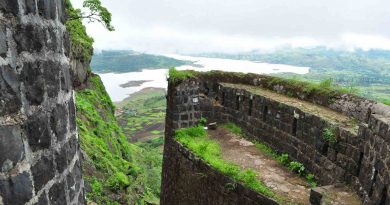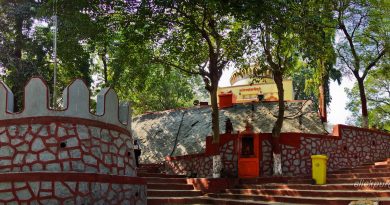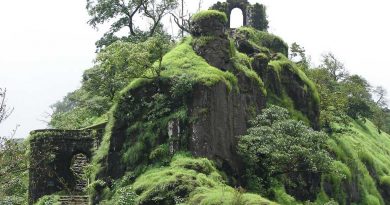Ahmednagar Fort
The Ahmednagar Fort is located in the heart of the city of Ahmednagar,Maharashtra. It was the headquarters of the Ahmednagar Sultanate. In 1803 it was taken by the British in during the Second Anglo-Maratha War. Later it was used by the British Raj as a prison. Currently the fort is under the administration of the Armoured Corps of the Indian Army.
The fort was built by Malik Shah Ahmed (after whom the city of Ahmednagar is named) in 1427 CE. He was the first sultan of the Nizam Shahi dynasty and he built the fort to defend the city against invaders from neighbouring Idar. Initially it was made of mud but major fortification began in 1559 under Hussain Nizam Shah. It took four years and was finally finished in 1562. In 1596, Chand Bibi the queen regent successfully repulsed the Mughal invasion but when Akbar attacked again in 1600 the fort went to the Mughals.
Aurangzeb died at Ahmednagar fort at the age of 88 on February 20, 1707.After Aurangzeb’s death the fort passed to the Nizams in 1724, to Marathas in 1759 and later the Scindias in 1790. During the period of instability in the Maratha Empire following the death of Madhavrao II, Daulat Scindia had the fort and its surrounding region ceded to him. In 1797, he imprisoned Nana Phadanvis the Peshwa diplomat at Ahmednagar fort.
Major features:
In 1803 the Ahmednagar Fort was round in appearance, with twenty-four bastions, one large gate, and three small sally ports. It had a glacis, no covered way; a ditch, revetted with stone on both sides, about 18 feet (5.5 m) wide, with 9 feet (2.7 m) water all round, which only reached within 6 or 7 feet (2.1 m) of the top of the scarp; long reeds grew in it all round. The berm was only about one yard wide. The rampart was of black hewn stone; the parapet of brick in chunam, and both together appeared from the crest of the glacis to be only as high as the pole of a field-officer’s tent. The bastions were all about 4½ feet higher; they were round. One of them mounted eight guns en barbet: it pointed to the eastward; all the rest had jingies, four in each. In 1803 two guns were visible in each bastion, and 200 were said to be ready in the fort to be mounted.
A gunshot to the west of the fort was the Pettah of Ahmednagar. The main gate of the fort faced the pettah, and was defended by a small half-circular work, with one traverse and several little towers for men. There is was a wooden bridge over the ditch, which could be taken away in time of war, but it was not a drawbridge. It was reported that an iron trough as large as the bridge, could be placed upon it, or on the supporters of it, and fill with charcoal or other combustibles, to which could be ignited as an enemy approached.
A small river came from the northward, round the west side of the pettah, and passed to the southward of the fort. A nullah also passed from the northward, between the fort and a town called Bhingar, about a gunshot to the eastward, and joined the river. A potential defensive weakness was a little hill or rising ground close to and east of Bhingar, from which shot from siege guns could reach the fort.
Two nills or covered aqueducts came from the hills, a mile or more to the north, passed through and supplied the pettah and the town, and then went into the fort, either under or through the ditch, into which the waste water fell.
There were no passages across the ditch from the sally ports, and no part of the aqueducts appeared above the ditch. The nullah mentioned above, had steep banks and passed within 60 yards of the fort; the aqueduct from Bhingar passed under it. There was no bridge or even a prominent crossing point at the nullah and hence no clearly defined route between the fort and the town of Bhingar.
There were many small pagodas and mosques round the pettah and the fort, but none exactly between, or between the fort and Bhingar, or nearer to the fort than those towns.
How to reach:
Rail:
Ahmednagar railway station (station code:ANG) is an important station which belongs to Solapur Division of Central Railway zone of the Indian Railways. Ahmednagar has rail connectivity with Pune, Manmad, Shirdi, Daund, Goa, Nasik.and metros New Delhi, Mumbai, Chennai, Kolkata, Bangalore, Ahmedabad There is still a demand for direct rail connectivity to other major cities of India. Total 41 Express Trains Stops at this Station.
Road:
Ahmednagar is well connected by roads with various major cities of Maharashtra and other states. National Highway 222 from Kalyan to Nirmal near Adilabad in Andhra Pradesh passes through the city. Ahmednagar has 4 lane road connectivity to Aurangabad, Pune, Nashik, Beed, Solapur
Local transport:
The Maharashtra State Road Transport Corporation (MSRTC) and numerous other private bus operators provide bus service connecting the city to all parts of the state. Prasanna Purple Ltd. operates an intra-city bus service called AMT Bus Service which connects different parts of the city together along with connecting the city to its nearby suburbs.




